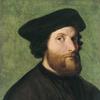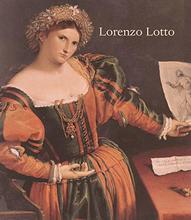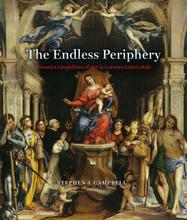More about Brother Gregorio Belo of Vicenza
- All
- Info
- Shop

Sr. Contributor
It may look like good old Brother Gregorio is experiencing chest pains, but don’t worry. He’s just really into his religion.
Much like Transformers, there’s more than meets the eye when it comes to a great portrait. Think of portraits that have stuck with you. A great portrait always has a certain je ne sais quoi; something that goes beyond appearance to pique your interest and maintain your gaze. Albrecht Dürer knew this – he practically invented it. Centuries later, Diane Arbus also knew this. And apparently so did our friend Lorenzo Lotto.
Lotto was a sixteenth-century Venetian painter of religious scenes and portraits. Although he trained alongside Renaissance masters like Giorgione and Titian, Lotto’s work looks a bit...different. He’s more similar to Dürer and Hans Holbein than any of his Italian compatriots. Lotto admired the northern portraitists’ concern for conveying more than just a likeness. These artists also captured the sitter’s psyche.
Towards the end of his career, Lotto focused on his expressive portraits. Lotto’s approach is rather obvious. As Brother Gregorio emulates Saint Jerome, the leader of the religious order to which he belonged, he meditates on a Crucifixion scene, which is conveniently placed right behind him. The only thing this painting is missing is a thought bubble. Like Gregorio, Lotto was deeply religious, and the amount of detail and attention this background scene is extraordinary.
This odd painting resides at the Metropolitan Museum of Art, and the means by which it entered the Museum are odder still. The Met acquired this painting using the money from the Rogers fund, a nice chunk of change named after a rich benefactor. Jacob S. Rogers was the President of Rogers Locomotive Works in Paterson, New Jersey, a position that he received because his father began a lucrative business. Despite his wealth, Rogers pretty much hoarded it all, so no one knew how many zeroes were in his bank account. Rogers was a committed member of the Museum and would sometimes visit Luigi Palma di Cesnola, the Met’s first director, frequently asking about the institution’s finances and operating costs. I guess di Cesnola was pretty clueless because it never occurred to him that Rogers might want to write the Met a fat check, a faux pas that would horrify any museum development team today. Upon his death in 1901, he left the Met an $8 million gift that would later become known as the Rogers fund. The Met didn’t realize Rogers’s will bestowed such a grand gift to the Museum. They learned about it by reading the newspaper like everybody else. In today’s money, the fund would have equaled over $170 million, and the Met has put this money to good use. The Rogers Fund has footed the bill for thousands of artworks, including this Lotto, many Egyptian artworks, and even an entire bedroom from a Roman villa that was preserved in the explosion of Mount Vesuvius.
Sources
- Bloom, Jonathan. “This Weekend in Met History: July 2.” Blogs. Now at The Met. 1 July 2011. The Metropolitan Museum of Art. https://www.metmuseum.org/blogs/now-at-the-met/features/2011/this-weeke…. Accessed 26 March 2020.
- Brown, David Alan, Peter Humfrey, and Mauro Lucco, Lorenzo Lotto: Rediscovered Master of the Renaissance. Washington, DC: National Gallery of Art, 1997.
- Catholic Online. “St. Jerome.” Saints & Angels. https://www.catholic.org/saints/saint.php?saint_id=10. Accessed 26 March 2020.
- Hartt, Frederick, and David G. Wilkins. History of Italian Renaissance Art: Painting, Sculpture, Architecture. Upper Saddle River, NJ: Pearson Prentice Hall, 2007.
- The J. Paul Getty Museum. “Lorenzo Lotto.” Artists. Collection. http://www.getty.edu/art/collection/artists/600/lorenzo-lotto-italian-v…. Accessed 26 March 2020.
- The Metropolitan Museum of Art. “Brother Gregorio Belo of Vicenza.” Collection. https://www.metmuseum.org/art/collection/search/436917. Accessed 26 March 2020.
- The National Gallery. “Lorenzo Lotto.” Artists. https://www.nationalgallery.org.uk/artists/lorenzo-lotto. Accessed 26 March 2020.
Featured Content
Here is what Wikipedia says about Portrait of Brother Gregorio Belo of Vicenza

Portrait of Brother Gregorio Belo of Vicenza is a 1547 oil-on-canvas painting by the Italian High Renaissance artist Lorenzo Lotto, now in the Metropolitan Museum of Art in New York. It is inscribed bottom right "F. Gregorr belo de Vicentia / eremite in Hieronimi Ordinis beati / fratri Petris de Pisis Anno / etatis eius LV, M.D.XLVII". Its subject was a Hieronymite monk and so the image's iconography draws on that of the penitent St Jerome.
It is recorded in Lotto's own commonplace book as commissioned on 9 December 1546 by its subject and completed in October 1547. Johann Matthias von der Schulenburg acquired it in Venice in 1738 for 26 zecchini as a work by Paolo Veronese and it remained in his family until being sold to its present owner in 1965. It was only correctly attributed to Lotto in a post-1924 catalogue of the Schulenburg family collections.
Check out the full Wikipedia article about Portrait of Brother Gregorio Belo of Vicenza














